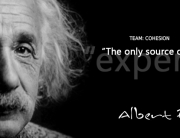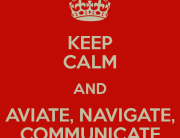Not even a mile of visibility, and high gusting winds chasing snow around the airport in frenzied eddies of flurries and white powder. A typical winter day up north, with a strong low pressure system moving accross and offering all sorts of challenges to anybody daring enough to go fly that day.
Was I daring? – or simply doing my job?… I pondered as I waited for the hangar door to open. I accepted the trip based on our company’s SOPs and my own comfort level, knowing full well that although the ride would be rough, it would none-the-less be safe. I quickly found out that not everybody felt the same way. One of the paramedics, pulling me aside, pointed a finger at the winter storm blowing outside the open hangar door. “Just so you know” he stated boldly, “I do not feel comfortable going flying in this weather”. And with this he stormed past me mumbling to himself, visibly upset by his apparently impending doom.
What was I to do? Good CRM would dictate that I take some time to communicate my thoughts clearly, and ensure that the “crew” – in this particular instance the paramedics – knew I was only doing my job. After all, I was confident in my weather and safety assessment of the trip. But an angry (and possibly scared) paramedic could also be a liability to any patient we might have to transport. I wasn’t sure the “Good CRM” card would be sufficient. Why?
To understand this situation and question better, here’s a quick look at a definition of CRM:
Did you know that 2/3rd of aircraft accidents are due to human factors? (source) Crew resource management or Cockpit resource management (CRM) is a procedure and training system in systems where human error can have devastating effects. Used primarily for improving air safety, CRM focuses on interpersonal communication, leadership, and decision making in the cockpit. (Source: Wikipedia)
I like this definition because it outlines both the strength and weakness of CRM. Although teaching CRM to professional pilots has done a tremendous job in reducing incidents related to poor interpersonal or leadership skills in the cockpit, it still has one major downfall: it’s definition – and application – is tagged “cockpit only”. Because it works by “recognizing that a discrepancy between what is happening and what should be happening is often the first indicator that an error is occurring” (Wikipedia), it only works as a reactionary tool most of the time. We teach that “Good CRM” will make managing airborne emergencies better. We teach that “Good CRM” will help the crew mitigate conflicts in the cockpit and thus reduce the chance for bad decisions, etc..
But I like to think that a flight doesn’t start only when you go wheels up – and certainly does not end the moment you touch down. The operation of an airplane is one thing, but rendering services during the operation of an airplane is a whole other ball game. It includes not only the pilots, but also the rest of the team of professionals involved – from the cabin crew to the ramp workers, and so on.
This lead me to question the true effectiveness of CRM on a global operational scale. True it strengthens cohesion within the cockpit crew, but what about the rest of the team? I was once asked how I would describe a good captain: the first image that came to mind was an orchestra conductor. As a team leader, a captain must know the music play by play, beat by beat. But he must also intrinsically trust every member of his team to do their own part with all the precision that their training and experience offers. If he is not in tune, so to speak, with every player in his team, then notes start getting lost and beats skipped… and the well rehearsed symphony becomes cacophony.
 The T.E.A.M. idea takes a fresh look into CRM, allowing crew-members to truly understand the variables involved inside AND outside of the cockpit, during all phases of the flight.
The T.E.A.M. idea takes a fresh look into CRM, allowing crew-members to truly understand the variables involved inside AND outside of the cockpit, during all phases of the flight.
Threat & Error Assessment & Management defines the challenges faced by pilots in an airline or any operation offering inflight services. It is crucial to first of all understand that the team does not only comprise of the personnel onboard the aircraft during its mission, but anybody involved in the success of the mission. Taking the 3 main parts of a flight mission – Pre-flight; In-flight; Post-flight – I’ll expand on the different aspects pilots must understand and foster to promote the highest safety and customer experience possible.
1) Preflight
-TEAM Assessment (EiQ; understanding your team’s strenghts & limits)
-TEAM Communication (Communications styles)
-TEAM Work (How your team’s training will affect the success and safety of your flight)
2) In-Flight
-TEAM Awareness (situational awareness; identifying threats and errors)
-TEAM Management (leadership models & styles; managing threats and errors during flight)
-TEAM Cohesion (Using all the available resources and personnel to ensure safety and success)
3) Post Flight
-TEAM Review: The Secrets and Benefits of Debriefing
-TEAM Success: The Super-Hero Syndrome
Using this model, it will also be imperative to explore and understand the difference between Threats and Errors, what causes them and how to deal with them respectively.
I hope that after completing this study, we will be able to approach every flight with a better understanding of our responsibilities as well as the tools we can use to deliver performance and safety as a professional team, and not individual professionals.





























Leave A Comment